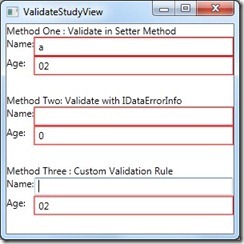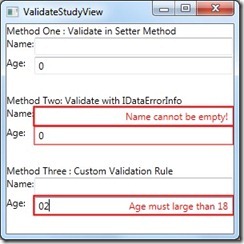[WPF 基础知识系列] —— 绑定中的数据校验Vaildation
前言:
只要是有表单存在,那么就有可能有对数据的校验需求。如:判断是否为整数、判断电子邮件格式等等。
WPF采用一种全新的方式 - Binding,来实现前台显示与后台数据进行交互,当然数据校验方式也不一样了。
本专题全面介绍一下WPF中4种Validate方法,帮助你了解如何在WPF中对binding的数据进行校验,并处理错误显示。
一、简介
正常情况下,只要是绑定过程中出现异常或者在converter中出现异常,都会造成绑定失败。
但是WPF不会出现任何异常,只会显示一片空白(当然有些Converter中的异常会造成程序崩溃)。
这是因为默认情况下,Binding.ValidatesOnException为false,所以WPF忽视了这些绑定错误。
但是如果我们把Binding.ValidatesOnException为true,那么WPF会对错误做出以下反应:
- 设置绑定元素的附加属性 Validation.HasError为true(如TextBox,如果Text被绑定,并出现错误)。
- 创建一个包含错误详细信息(如抛出的Exception对象)的ValidationError对象。
- 将上面产生的对象添加到绑定对象的Validation.Errors附加属性当中。
- 如果Binding.NotifyOnValidationError是true,那么绑定元素的附加属性中的Validation.Error附加事件将被触发。(这是一个冒泡事件)
我们的Binding对象,维护着一个ValidationRule的集合,当设置ValidatesOnException为true时,
默认会添加一个ExceptionValidationRule到这个集合当中。
PS:对于绑定的校验只在Binding.Mode 为TwoWay和OneWayToSource才有效,
即当需要从target控件将值传到source属性时,很容易理解,当你的值不需要被别人使用时,就很可能校验也没必要。
二、四种实现方法
1、在Setter方法中进行判断
直接在Setter方法中,对value进行校验,如果不符合规则,那么就抛出异常。然后修改XAML不忽视异常。
public class PersonValidateInSetter : ObservableObject
{
private string name;
private int age;
public string Name
{
get { return this.name; }
set
{
if (string.IsNullOrWhiteSpace(value))
{
throw new ArgumentException("Name cannot be empty!");
} if (value.Length < )
{
throw new ArgumentException("Name must have more than 4 char!");
}
this.name = value;
this.OnPropertyChanged(() => this.Name);
}
}
public int Age
{
get
{ return this.age; }
set
{
if (value < )
{
throw new ArgumentException("You must be an adult!");
}
this.age = value;
this.OnPropertyChanged(() => this.Age);
}
}
}
<Grid DataContext="{Binding PersonValidateInSetter}">
<Grid.RowDefinitions>
<RowDefinition />
<RowDefinition />
</Grid.RowDefinitions>
<Grid.ColumnDefinitions>
<ColumnDefinition Width="Auto" />
<ColumnDefinition />
</Grid.ColumnDefinitions>
<TextBlock Text="Name:" />
<TextBox Grid.Column="1"
Margin="1"
Text="{Binding Name,
ValidatesOnExceptions=True,
UpdateSourceTrigger=PropertyChanged}" />
<TextBlock Grid.Row="1" Text="Age:" />
<TextBox Grid.Row="1"
Grid.Column="1"
Margin="1"
Text="{Binding Age,
ValidatesOnExceptions=True,
UpdateSourceTrigger=PropertyChanged}" />
</Grid>
当输入的值,在setter方法中校验时出现错误,就会出现一个红色的错误框。
关键代码:ValidatesOnExceptions=True, UpdateSourceTrigger=PropertyChanged。
PS:这种方式有一个BUG,首次加载时不会对默认数据进行检验。
2、继承IDataErrorInfo接口
使Model对象继承IDataErrorInfo接口,并实现一个索引进行校验。如果索引返回空表示没有错误,如果返回不为空,
表示有错误。另外一个Erro属性,但是在WPF中没有被用到。
public class PersonDerivedFromIDataErrorInfo : ObservableObject, IDataErrorInfo
{
private string name;
private int age;
public string Name
{
get
{
return this.name;
}
set
{
this.name = value;
this.OnPropertyChanged(() => this.Name);
}
}
public int Age
{
get
{
return this.age;
}
set
{
this.age = value;
this.OnPropertyChanged(() => this.Age);
}
}
// never called by WPF
public string Error
{
get
{
return null;
}
}
public string this[string propertyName]
{
get
{
switch (propertyName)
{
case "Name":
if (string.IsNullOrWhiteSpace(this.Name))
{
return "Name cannot be empty!";
}
if (this.Name.Length < )
{
return "Name must have more than 4 char!";
}
break;
case "Age":
if (this.Age < )
{
return "You must be an adult!";
}
break;
}
return null;
}
}
}
<Grid DataContext="{Binding PersonDerivedFromIDataErrorInfo}">
<Grid.RowDefinitions>
<RowDefinition />
<RowDefinition />
</Grid.RowDefinitions>
<Grid.ColumnDefinitions>
<ColumnDefinition Width="Auto" />
<ColumnDefinition />
</Grid.ColumnDefinitions>
<TextBlock Text="Name:" />
<TextBox Grid.Column="1"
Margin="1"
Text="{Binding Name,
NotifyOnValidationError=True,
ValidatesOnDataErrors=True,
UpdateSourceTrigger=PropertyChanged}" />
<TextBlock Grid.Row="1" Text="Age:" />
<TextBox Grid.Row="1"
Grid.Column="1"
Margin="1"
Text="{Binding Age,
NotifyOnValidationError=True,
ValidatesOnDataErrors=True,
UpdateSourceTrigger=PropertyChanged}" />
PS:这种方式,没有了第一种方法的BUG,但是相对很麻烦,既需要继承接口,又需要添加一个索引,如果遗留代码,那么这种方式就不太好。
3、自定义校验规则
一个数据对象或许不能包含一个应用要求的所有不同验证规则,但是通过自定义验证规则就可以解决这个问题。
在需要的地方,添加我们创建的规则,并进行检测。
通过继承ValidationRule抽象类,并实现Validate方法,并添加到绑定元素的Binding.ValidationRules中。
public class MinAgeValidation : ValidationRule
{
public int MinAge { get; set; } public override ValidationResult Validate(object value, CultureInfo cultureInfo)
{
ValidationResult result = null; if (value != null)
{
int age; if (int.TryParse(value.ToString(), out age))
{
if (age < this.MinAge)
{
result = new ValidationResult(false, "Age must large than " + this.MinAge.ToString(CultureInfo.InvariantCulture));
}
}
else
{
result = new ValidationResult(false, "Age must be a number!");
}
}
else
{
result = new ValidationResult(false, "Age must not be null!");
} return new ValidationResult(true, null);
}
}
<Grid>
<Grid.RowDefinitions>
<RowDefinition />
<RowDefinition />
</Grid.RowDefinitions>
<Grid.ColumnDefinitions>
<ColumnDefinition Width="Auto" />
<ColumnDefinition />
</Grid.ColumnDefinitions>
<TextBlock Text="Name:" />
<TextBox Grid.Column="1" Margin="1" Text="{Binding Name}">
</TextBox>
<TextBlock Grid.Row="1" Text="Age:" />
<TextBox Grid.Row="1"
Grid.Column="1"
Margin="1">
<TextBox.Text>
<Binding Path="Age"
UpdateSourceTrigger="PropertyChanged"
ValidatesOnDataErrors="True">
<Binding.ValidationRules>
<validations:MinAgeValidation MinAge="18" />
</Binding.ValidationRules>
</Binding>
</TextBox.Text>
</TextBox>
</Grid>
这种方式,也会有第一种方法的BUG,暂时还不知道如何解决,但是这个能够灵活的实现校验,并且能传参数。
效果图:

4、使用数据注解(特性方式)
在System.ComponentModel.DataAnnotaions命名空间中定义了很多特性,
它们可以被放置在属性前面,显示验证的具体需要。放置了这些特性之后,
属性中的Setter方法就可以使用Validator静态类了,来用于验证数据。
public class PersonUseDataAnnotation : ObservableObject
{
private int age;
private string name;
[Range(, , ErrorMessage = "Age must be a positive integer")]
public int Age
{
get
{
return this.age;
}
set
{
this.ValidateProperty(value, "Age");
this.SetProperty(ref this.age, value, () => this.Age);
}
}
[Required(ErrorMessage = "A name is required")]
[StringLength(, MinimumLength = , ErrorMessage = "Name must have at least 3 characters")]
public string Name
{
get
{
return this.name;
}
set
{
this.ValidateProperty(value, "Name");
this.SetProperty(ref this.name, value, () => this.Name);
}
}
protected void ValidateProperty<T>(T value, string propertyName)
{
Validator.ValidateProperty(value,
new ValidationContext(this, null, null) { MemberName = propertyName });
}
}
<Grid>
<Grid.RowDefinitions>
<RowDefinition />
<RowDefinition />
</Grid.RowDefinitions>
<Grid.ColumnDefinitions>
<ColumnDefinition Width="Auto" />
<ColumnDefinition />
</Grid.ColumnDefinitions>
<TextBlock Text="Name:" />
<TextBox Grid.Column="1"
Margin="1"
Text="{Binding Name,
ValidatesOnExceptions=True,
UpdateSourceTrigger=PropertyChanged}" />
<TextBlock Grid.Row="1" Text="Age:" />
<TextBox Grid.Row="1"
Grid.Column="1"
Margin="1"
Text="{Binding Age,
ValidatesOnExceptions=True,
UpdateSourceTrigger=PropertyChanged}" />
</Grid>
使用特性的方式,能够很自由的使用自定义的规则,而且在.Net4.5中新增了很多特性,可以很方便的对数据进行校验。
例如:EmailAddress, Phone, and Url等。
三、自定义错误显示模板
在上面的例子中,我们可以看到当出现验证不正确时,绑定控件会被一圈红色错误线包裹住。
这种方式一般不能够正确的展示出,错误的原因等信息,所以有可能需要自己的错误显示方式。
前面,我们已经讲过了。当在检测过程中,出现错误时,WPF会把错误信息封装为一个ValidationError对象,
并添加到Validation.Errors中,所以我们可以取出错误详细信息,并显示出来。
1、为控件创建ErrorTemplate
下面就是一个简单的例子,每次都把错误信息以红色展示在空间上面。这里的AdornedElementPlaceholder相当于
控件的占位符,表示控件的真实位置。这个例子是在书上直接拿过来的,只能做基本展示用。
<ControlTemplate x:Key="ErrorTemplate">
<Border BorderBrush="Red" BorderThickness="2">
<Grid>
<AdornedElementPlaceholder x:Name="_el" />
<TextBlock Margin="0,0,6,0"
HorizontalAlignment="Right"
VerticalAlignment="Center"
Foreground="Red"
Text="{Binding [0].ErrorContent}" />
</Grid>
</Border>
</ControlTemplate>
<TextBox x:Name="AgeTextBox"
Grid.Row="1"
Grid.Column="1"
Margin="1" Validation.ErrorTemplate="{StaticResource ErrorTemplate}" >
使用方式非常简单,将上面的模板作为逻辑资源加入项目中,然后像上面一样引用即可。
效果图:

对知识梳理总结,希望对大家有帮助!
[WPF 基础知识系列] —— 绑定中的数据校验Vaildation的更多相关文章
- 基础知识系列☞C#中→属性和字段的区别
"好吧...准备写个'基础知识系列',算是记录下吧,时时看看,更加加深记忆···" 其实本来准备叫"面试系列"... 字段.属性.你先知道的哪个概念? ***我 ...
- 基础知识系列☞C#中数组Array、ArrayList和List三者的区别
数组() #region 数组 //初始化方式_0:先声明再赋值 ]; weekDays_0[] = "Sun"; weekDays_0[] = "Mon"; ...
- [C# 基础知识系列]C#中易混淆的知识点
一.引言 今天在论坛中看到一位朋友提出这样的一个问题,问题大致(问题的链接为:http://social.msdn.microsoft.com/Forums/zh-CN/52e6c11f-ad28-4 ...
- 基础知识系列☞C#中→委托
有些.NET中的高级特性,比如:委托! 有一种怎么也搞不懂的赶脚... 博客读了好几篇,代码也动手写了,书中的一些介绍也看了, 各种搜索关于委托的,至今还处于"会用"的阶段. 该怎 ...
- C# 基础知识系列- 3 集合数组
简单的介绍一下集合,通俗来讲就是用来保管多个数据的方案.比如说我们是一个公司的仓库管理,公司有一堆货物需要管理,有同类的,有不同类的,总而言之就是很多.很乱.我们对照集合的概念对仓库进行管理的话,那么 ...
- C# 基础知识系列- 9 字符串的更多用法(一)
0. 前言 在前面的文章里简单介绍了一下字符串的相关内容,并没有涉及到更多的相关内容,这一篇将尝试讲解一下在实际开发工作中会遇到的字符串的很多操作. 1. 创建一个字符串 这部分介绍一下如何创建一个字 ...
- C# 基础知识系列-13 常见类库(三)
0. 前言 在<C# 基础知识系列- 13 常见类库(二)>中,我们介绍了一下DateTime和TimeSpan这两个结构体的内容,也就是C#中日期时间的简单操作.本篇将介绍Guid和Nu ...
- C# 基础知识系列- 14 IO篇 文件的操作 (3)
本篇继续前两篇内容,跟大家介绍一下Path类以及FileSystemInfo这个类的主要方法和属性. 上文提到,在<C# 基础知识系列-IO篇>之文件相关的内容完结之后,会带领大家开发一个 ...
- C# 基础知识系列- 14 IO篇 流的使用
0. 前言 继续之前的C# IO流,在前几篇小短片中我们大概看了下C# 的基础IO也对文件.目录和路径的操作有了一定的了解.这一篇开始,给大家演示一下流的各种操作.以文件流为例,一起来看看如何操作吧. ...
随机推荐
- Git for Windows之分支管理、分支合并、解决分支冲突
分支是在稳定版本出现bug的情况下,通过分支技术,在保证稳定版本稳定的情况,修改稳定版本的(差异下载的,速度极快,不同于SVN等技术,会将所有的代码下载到本地)副本,通过合并,解决冲突,最后回归到稳定 ...
- C++中:默认构造函数、析构函数、拷贝构造函数和赋值函数——转
对于一个空类,编译器默认产生4个成员函数:默认构造函数.析构函数.拷贝构造函数和赋值函数.1.构造函数:构造函数是一种特殊的类成员,是当创建一个类的时候,它被调用来对类的数据成员进行初始化和分配内存. ...
- Postman入门
- spring@Transactional注解事务不回滚不起作用无效的问题处理
这几天在项目里面发现我使用@Transactional注解事务之后,抛了异常居然不回滚.后来终于找到了原因. 如果你也出现了这种情况,可以从下面开始排查. 一.特性先来了解一下@Transaction ...
- Apache本地配置虚拟域名
转载+修改 例:虚拟域名为 aaa.com 端口为默认80 index.html所在目录 D:/wamp/www/web 不用解析域名,使用虚假的域名也可以 apache安装完默认是不开启虚拟服务器 ...
- 使用Nagios打造专业的业务状态监控
想必各个公司都有部署zabbix之类的监控系统来监控服务器的资源使用情况.各服务的运行状态,是否这种监控就足够了呢?有没有遇到监控系统一切正常确发现项目无法正常对外提供服务的情况呢?本篇文章聊聊我们如 ...
- 查看 postgresql 数据库编码,以及修改数据库编码
查看数据表编码: \encoding 修改数据库编码: update pg_database set encoding = pg_char_to_encoding('UTF8') where datn ...
- Linux LAMP 配置
一.安装必要的软件 yum install -y update yum install pcre yum install openssl* yum -y install gcc gcc-c++ aut ...
- 第一次项目上Linux服务器(二:——安装jdk)
本人采用的是rpm安装jdk1.8 1.下载jdk 去jdk下载页面找到要下载的jdk 本人下载的是jdk-8u161-linux-x64.rpm,百度云资源链接:链接:https://pan.bai ...
- 让浏览器兼容ES6语法(gulp+babel)
使用gulp+babel搭建ES6环境 前言 我们查阅资料可以知道ECMAScript 2015(简称ES6)已经于2015年发布,由于用户使用的浏览器版本在安装的时候可能早于ES6的发布,而到了今天 ...
